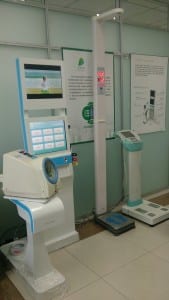A secondment at Tsinghua University, Beijing, China
By Nathan Davies, on 16 December 2015
Rosa Lau, PhD student (PCPH), talks about her experience of working in Tsinghua University, China.
I was recently lucky enough to spend one month on a secondment at Tsinghua University in Beijing China, through the Ubi-HEALTH program. The main focus of the Ubi-HEALTH exchange program is to build and establish a network to disseminate knowledge regarding available technologies for healthcare to be shared between students, researchers and host institutions between different countries. It primarily operates in Europe, Mexico, Chile, China and the USA.
Tsinghua University (清华大学) was established in 1911 and is ranked as one of the best universities in mainland China. The university covers an area of 392 hectares and facilities include sports centres, book shops, banks, hospitals, primary and secondary schools, community centres, cafes, supermarkets, and over 10 dining halls and restaurants. On my first day, I was advised to buy a second hand bike just to travel within and around campus.
Over the one month period, I worked in the Research Institute of Information Technology with Professor Yongqiang Lyu and his team. There are a number of Research and Development (R&D) Centres within the research institute including the Future Information Technology (FIT) Centre and eHealth Centre.
Professor Lyu and his team developed an interactive self-service healthcare kiosk for the community. The kiosk integrates various medical devices and sensors for assessing the physiological characteristics of users, such as blood pressure, electrocardiography (ECG), pulse rate, blood glucose, blood oxygen, body composition (e.g. height, weight, body mass index, body water, muscle mass, body fat, waist-hip ratio) enabling an overall health score to be computed. Following use, a summary results report can be printed. In addition, users can access their digital report on their mobile phones and share the information with their friends and family via WeChat (a mobile text and voice messaging communication service, similar to WhatsApp) or, by scanning the QR (Quick Response) code provided in the paper report. A QR barcode can store a large amount of data that enables links to videos, Twitter or website pages. Some work around testing accuracy with users was carried out previously and the product is currently undergoing commercial deployment.
While on my secondment I visited the China Open Tennis Tournament to observe how the health care kiosk was delivered and used in this particular setting (i.e. a public event), as well as people’s experience with the kiosk . Its use was facilitated by staff to ensure smooth operations in between tennis games. My field notes along with some implications and design recommendations (e.g. interpretation of results, graphical user interface (GUI)) were shared and discussed with the team. I also produced a document outlining a number of issues to consider if it were to be implemented and/or delivered in other settings, such as office buildings. In addition, I helped develop the educational content, particularly information related to blood pressure, body mass index, basal metabolic rate and cardiovascular disease, as well as lifestyle options and healthy living, all of which were based on evidence. All of this work has contributed towards the next phase of intervention development, ready for evaluation at a later stage.
Towards the end of the secondment, I gave a seminar to a group of graduate students. The seminar covered the following areas:
- Brief introduction to the eHealth unit at UCL
- How the Medical Research Council Framework can be used to develop and evaluate e-health technologies using a few examples from the unit
- Introduced the concept of implementation, why it is important, issues we need to consider and how it can be studied (my PhD project)
The presentation was well received – the students were very engaged and asked some really interesting questions. After the seminar I was asked by the students to stay and sit in their group meetings where they discussed their projects and received feedback from their tutors. It was an informal event and participation was voluntary. It was exciting to hear about their innovative work related to health and education. It was a stimulating environment, where they all shared their progress and challenges.
Beside work, I was invited to a formal welcome lunch and numerous meals with staff and students. I took a trip to Yuanmingyuan (also known as the Old Summer Palace) with the students, as well as visiting other well-known areas such as the Tiananmen Square, some Hutongs (old city alleys), Lama Temple and 398 Art district. I also had the opportunity to watch a live tennis female doubles match at the China Open!
Overall it was an invaluable experience to live and work in China. I am extremely grateful to Ubi-HEALTH program for the opportunity and to Professor Lyu’s group for their kind hospitality.
For more information contact Rosa Lau.
 Close
Close




